Papers by Justin A Welbergen
Canaries in the coalmine - impacts of extreme heat events on flying-foxes
Wet Tropics Biodiversity Research Library
ABSTRACT This is the Endnote Library of the peer-reviewed and the grey literature on biodiversity... more ABSTRACT This is the Endnote Library of the peer-reviewed and the grey literature on biodiversity research in the Australian Wet Tropics (N > 2500 references, as per 2011), that accompanies the "Gap analysis of environmental research needs in the Australian Wet Tropics".
The sensitivity of Australian birds to climate change
Wet Tropics Biodiversity Research Library
This is the Endnote Library of the peer-reviewed and the grey literature on biodiversity research... more This is the Endnote Library of the peer-reviewed and the grey literature on biodiversity research in the Australian Wet Tropics (N > 2500 references, as per 2011), that accompanies the "Gap analysis of environmental research needs in the Australian Wet Tropics".

Climate change and the impacts of extreme events on Australia’s Wet Tropics biodiversity
While gradual changes in climate means will have numerous effects on a range of environmental, so... more While gradual changes in climate means will have numerous effects on a range of environmental, social, and economic sectors, emerging evidence shows that many of the environmental, social, and economic impacts of anthropogenic climate change will arise from shifts in the regimes of extreme weather and climatic events, including heat waves, fires, flooding rain, and cyclones (IPCC 2012, IPCC 2013). Such extreme events represent the way in which communities, animals and plants experience climate change (BoM-CSIRO 2006). However, despite their clear importance for our understanding of climate change impacts (and hence adaptation action), very little is known about the effects of extreme events on natural systems (IPCC 2012, Welbergen et al 2008a). Tropical rainforests are the hotbed of the world’s biodiversity; yet, the vulnerability of tropical rainforest biota to extreme temperature events is largely unknown (Williams et al 2008). This project investigates the exposure and sensitivit...
Warren et al 2013 Supplementary Information
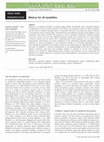
Mimicry is a canonical example of adaptive signal design. In principle, what constitutes mimicry ... more Mimicry is a canonical example of adaptive signal design. In principle, what constitutes mimicry is independent of the taxonomic identity of the mimic, the ecological context in which it operates, and the sensory modality through which it is expressed. However, in practice the study of mimicry is inconsistent across research fields, with theoretical and empirical advances often failing to cross taxonomic and sensory divides. We propose a novel conceptual framework whereby mimicry evolves if a receiver perceives the similarity between a mimic and a model and as a result confers a selective benefit onto the mimic. Here, misidentification and/or deception are no longer formal requirements, and mimicry can evolve irrespective of the underlying proximate mechanisms. The centrality of receiver perception in this framework enables us to formally distinguish mimicry from perceptual exploitation and integrate mimicry and multicomponent signalling theory for the first time. In addition, it resolves inconsistencies in our understanding of the role of learning in mimicry evolution, and shows that imperfect mimicry is expected to be the norm. Mimicry remains a key model for understanding signal evolution and cognition, and we recommend the adoption of a unified approach to stimulate future interdisciplinary developments in this fascinating area of research.
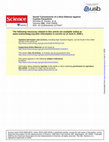
Science
Coevolutionary arms races between brood parasites and hosts involve genetic adaptations and count... more Coevolutionary arms races between brood parasites and hosts involve genetic adaptations and counter-adaptations. However, hosts sometimes acquire defenses too rapidly to reflect genetic change. Our field experiments show that observation of cuckoo (Cuculus canorus) mobbing by neighbors on adjacent territories induced reed warblers (Acrocephalus scirpaceus) to increase the mobbing of cuckoos but not of parrots (a harmless control) on their own territory. In contrast, observation of neighbors mobbing parrots had no effect on reed warblers’ responses to either cuckoos or parrots. These results indicate that social learning provides a mechanism by which hosts rapidly increase their nest defense against brood parasites. Such enemy-specific social transmission enables hosts to track fine-scale spatiotemporal variation in parasitism and may influence the coevolutionary trajectories and population dynamics of brood parasites and hosts.
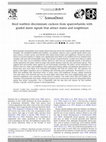
Current Biology
Coevolutionary arms races, where adaptations in one party select for counter-adaptations in anoth... more Coevolutionary arms races, where adaptations in one party select for counter-adaptations in another and vice versa, are fundamental to interactions between organisms and their predators, pathogens, and parasites [1]. Avian brood parasites and their hosts have emerged as model systems for studying such reciprocal coevolutionary processes [2] and [3]. For example, hosts have evolved changes in egg appearance and rejection of foreign eggs in response to brood parasitism from cuckoos, and cuckoos have evolved host-egg mimicry as a counter-response [4], [5] and [6]. However, the host's front line of defense is protecting the nest from being parasitized in the first place [7], [8], [9] and [10], yet little is known about the effectiveness of nest defense as an antiparasite adaptation, and its coevolutionary significance remains poorly understood [10]. Here we show first that mobbing of common cuckoos Cuculus canorus by reed warblers Acrocephalus scirpaceus is an effective defense against parasitism. Second, mobbing of cuckoos is a phenotypically plastic trait that is modified strategically according to local parasitism risk. This supports the view that hosts use a “defense in-depth strategy,” with successive flexible lines of defense that coevolve with corresponding offensive lines of the parasite. This highlights the need for more holistic research into the coevolutionary consequences when multiple adaptations and counter-adaptations evolve in concert [11].
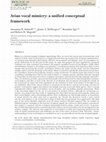
Mimicry is a classical example of adaptive signal design. Here, we review the current state of re... more Mimicry is a classical example of adaptive signal design. Here, we review the current state of research into vocal mimicry in birds. Avian vocal mimicry is a conspicuous and often spectacular form of animal communication, occurring in many distantly related species. However, the proximate and ultimate causes of vocal mimicry are poorly understood. In the first part of this review, we argue that progress has been impeded by conceptual confusion over what constitutes vocal mimicry. We propose a modified version of Vane-Wright's (1980) widely used definition of mimicry. According to our definition, a vocalisation is mimetic if the behaviour of the receiver changes after perceiving the acoustic resemblance between the mimic and the model, and the behavioural change confers a selective advantage on the mimic. Mimicry is therefore specifically a functional concept where the resemblance between heterospecific sounds is a target of selection. It is distinct from other forms of vocal resemblance including those that are the result of chance or common ancestry, and those that have emerged as a by-product of other processes such as ecological convergence and selection for large song-type repertoires. Thus, our definition provides a general and functionally coherent framework for determining what constitutes vocal mimicry, and takes account of the diversity of vocalisations that incorporate heterospecific sounds. In the second part we assess and revise hypotheses for the evolution of avian vocal mimicry in the light of our new definition. Most of the current evidence is anecdotal, but the diverse contexts and acoustic structures of putative vocal mimicry suggest that mimicry has multiple functions across and within species. There is strong experimental evidence that vocal mimicry can be deceptive, and can facilitate parasitic interactions. There is also increasing support for the use of vocal mimicry in predator defence, although the mechanisms are unclear. Less progress has been made in explaining why many birds incorporate heterospecific sounds into their sexual displays, and in determining whether these vocalisations are functionally mimetic or by-products of sexual selection for other traits such as repertoire size. Overall, this discussion reveals a more central role for vocal mimicry in the behavioural ecology of birds than has previously been appreciated. The final part of this review identifies important areas for future research. Detailed empirical data are needed on individual species, including on the structure of mimetic signals, the contexts in which mimicry is produced, how mimicry is acquired, and the ecological relationships between mimic, model and receiver. At present, there is little information and no consensus about the various costs of vocal mimicry for the protagonists in the mimicry complex. The diversity and complexity of vocal mimicry in birds raises important questions for the study of animal communication and challenges our view of the nature of mimicry itself. Therefore, a better understanding of avian vocal mimicry is essential if we are to account fully for the diversity of animal signals.
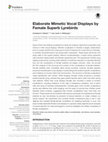
Some of the most striking vocalizations in birds are made by males that incorporate vocal mimicry... more Some of the most striking vocalizations in birds are made by males that incorporate vocal mimicry in their sexual displays. Mimetic vocalization in females is largely undescribed, but it is unclear whether this is because of a lack of selection for vocal mimicry in females, or whether the phenomenon has simply been overlooked. These issues are thrown into sharp relief in the superb lyrebird, Menura novaehollandiae, a basal oscine passerine with a lek-like mating system and female uniparental care. The spectacular mimetic song display produced by courting male lyrebirds is a textbook example of a sexually selected trait, but the vocalizations of female lyrebirds are largely unknown. Here, we provide the first analysis of the structure and context of the vocalizations of female lyrebirds. Female lyrebirds were completely silent during courtship; however, females regularly produced sophisticated vocal displays incorporating both lyrebird-specific vocalizations and imitations of sounds within their environment. The structure of female vocalizations varied significantly with context. While foraging, females mostly produced a complex lyrebird-specific song, whereas they gave lyrebird-specific alarm calls most often during nest defense. Within their vocal displays females also included a variety of mimetic vocalizations, including imitations of the calls of dangerous predators, and of alarm calls and song of harmless heterospecifics. Females gave more mimetic vocalizations during nest defense than while foraging, and the types of sounds they imitated varied between these contexts, suggesting that mimetic vocalizations have more than one function. These results are inconsistent with previous portrayals of vocalizations by female lyrebirds as rare, functionless by-products of sexual selection on males. Instead, our results support the hypotheses that complex female vocalizations play a role in nest defense and mediate female-female competition for breeding territories. In sum, this study reveals elaborate female vocal displays in a species widely depicted as an example of sexual selection for male extravagance, and thus highlights the hidden complexity of female vocalizations.
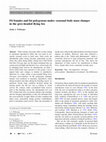
When females and males differ in their timing of maximum reproductive effort, this can result in ... more When females and males differ in their timing of maximum reproductive effort, this can result in sex-specific seasonal cycles in body mass. Such cycles are undoubtedly under strong selection, particularly in bats, where they affect flying ability. Flying foxes (Old World fruit bats, Pteropus spp.) are the largest mammals that can sustain powered flight and therefore face critical trade-offs in managing body reserves for reproduction, yet little is known about body mass dynamics in this group. I investigated body mass changes in relation to reproductive behaviour in a large colony of grey-headed flying foxes (Pteropus poliocephalus). In this polygynous mammal, females were predicted to maximise reproductive effort during lactation and males during the breeding season. As predicted, female body condition declined during the nursing period, but did not vary in relation to sexual activity. By contrast, males accumulated body reserves prior to the breeding season, but subsequently lost over 20% of their body mass on territory defence and courtship, and lost foraging opportunities as they also defended their day roost territories at night. Males in better condition had larger testes, particularly during territory establishment, prior to maximum sexual activity. Thus, the seasonality of female mass reflected the high metabolic load that lactation imposes on mothers. However, male mass followed a pattern akin to the “fatted male phenomenon”, which is commonly observed in large polygynous mammals with seasonal reproduction, but not in bats. This shows the importance of body reserves for reproduction in flying foxes, despite their severe constraints on body mass.
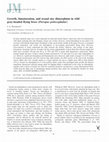
In many mammals large size is more important for male than female fitness, which may select for b... more In many mammals large size is more important for male than female fitness, which may select for bimaturation with males maturing later and attaining a larger size. In bats, however, sexual dimorphism in size tends to be reversed, with females being larger. Exceptions to this can be found, notably in the genus Pteropus. I examined growth, maturation, and sexual size dimorphism in free-ranging gray-headed flying foxes (Pteropus poliocephalus) to better understand the links between life history, behavior, and ecology of this large, polygynous Australian fruit bat. Juveniles left the colony independently at dusk when their forearm length and body mass exceeded 130 mm and 301 g, or 79% and 39% of mean adult dimensions, respectively. Mean forearm length and mass of these volant juveniles increased by 0.72 mm and 4.9 g per week, independent of sex. However, significant dimorphism and bimaturation were observed: adult males averaged 1.8–4.5% larger for skeletal measurements and 25% heavier than adult females, but 40% heavier at the start of the breeding season. Males also were sexually mature at a larger skeletal size and at a higher mass (604 g) than females (514 g). Sexual size dimorphism in P. poliocephalus likely results from prolonged male growth and delayed maturation. Intrasexual selection among males for fighting ability is implicated as the cause for dimorphism, together with a release of female size from the constraints posed by carrying heavy young. Bimaturation likely results from the high costs of maintaining mating territories that confer few reproductive benefits for small males.
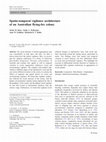
The social structure of animal aggregations may vary considerably in both space and time, yet lit... more The social structure of animal aggregations may vary considerably in both space and time, yet little is known about how this affects vigilance. Here, we investigate the vigilance architecture of a colony of wild-living grey-headed flying-foxes (Pteropus poliocephalus) in Australia and examine how spatial as well as temporal variation in social organization influences social and environmental vigilance. We sampled color-marked individuals at different stages of the reproductive cycle and the year and at different locations in the colony to examine the effects of temporal and spatial factors on social and environmental vigilance. We found that vigilance architecture reflected the social structure of the colony, with the highest environmental vigilance being displayed by bats at the periphery of the colony, and the highest social vigilance by bats that roosted at intermediate distances from the colony’s edge. Furthermore, we found that vigilance levels reflected changes in reproductive state, with social vigilance increasing toward the mating season, particularly in males. Our findings show that spatial and temporal variation in social structure can have differential effects on social and environmental vigilance. This highlights the necessity to differentiate between functions of vigilance to understand fully vigilance architecture in aggregations of social animals.
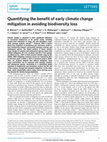
Nature Climate Change, 2013
Climate change is expected to have significant influences on terrestrial biodiversity at all syst... more Climate change is expected to have significant influences on terrestrial biodiversity at all system levels, including species-level reductions in range size and abundance, especially amongst endemic species1, 2, 3, 4, 5, 6. However, little is known about how mitigation of greenhouse gas emissions could reduce biodiversity impacts, particularly amongst common and widespread species. Our global analysis of future climatic range change of common and widespread species shows that without mitigation, 57±6% of plants and 34±7% of animals are likely to lose ≥50% of their present climatic range by the 2080s. With mitigation, however, losses are reduced by 60% if emissions peak in 2016 or 40% if emissions peak in 2030. Thus, our analyses indicate that without mitigation, large range contractions can be expected even amongst common and widespread species, amounting to a substantial global reduction in biodiversity and ecosystem services by the end of this century. Prompt and stringent mitigation, on the other hand, could substantially reduce range losses and buy up to four decades for climate change adaptation.
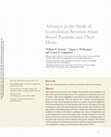
The interactions between avian obligate interspecific brood parasites and their hosts provide tra... more The interactions between avian obligate interspecific brood parasites and their hosts provide tractable systems for studying coevolutionary processes in nature. This review highlights recent advances in understanding coevo-lution in these systems. First, we discuss the evolution and phylogenetic history of avian brood parasitism. Next, we examine coevolved adaptations and counteradaptations in brood parasites and hosts at all stages of the host nesting cycle: those that precede laying of the parasitic egg and those at the egg, chick, and fledgling stages. We then consider the factors that affect the evolution of offense and defense portfolios (the suites of adaptations and counteradaptations across the nesting cycle), and the outcomes of coevolutionary interactions between brood parasites and hosts. Ongoing efforts to document the diversity of host defenses and parasite offenses will facilitate understanding of coevolutionary processes and the ecological and evolutionary consequences of species interactions in the natural world.
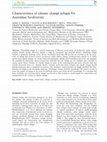
Identifying refugia is a critical component of effective conservation of biodiversity under anthr... more Identifying refugia is a critical component of effective conservation of biodiversity under anthro-pogenic climate change. However, despite a surge in conceptual and practical interest, identifying refugia remains a significant challenge across diverse continental landscapes. We provide an overview of the key properties of refugia that promote species' persistence under climate change, including their capacity to (i) buffer species from climate change; (ii) sustain long-term population viability and evolutionary processes; (iii) minimize the potential for deleterious species interactions, provided that the refugia are (iv) available and accessible to species under threat. Further, we classify refugia in terms of the environmental and biotic stressors that they provide protection from (i.e. thermal, hydric, cyclonic, pyric and biotic refugia), but ideally refugia should provide protection from a multitude of stressors. Our systematic characterization of refugia facilitates the identification of refugia in the Australian landscape. Challenges remain, however, specifically with respect to how to assess the quality of refugia at the level of individual species and whole species assemblages. It is essential that these challenges are overcome before refugia can live up to their acclaim as useful targets for conservation and management in the context of climate change.
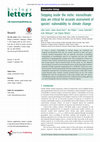
To assess a species' vulnerability to climate change, we commonly use mapped environmental data t... more To assess a species' vulnerability to climate change, we commonly use mapped environmental data that are coarsely resolved in time and space. Coarsely resolved temperature data are typically inaccurate at predicting temperatures in microhabitats used by an organism and may also exhibit spatial bias in topographically complex areas. One consequence of these inaccuracies is that coarsely resolved layers may predict thermal regimes at a site that exceed species' known thermal limits. In this study, we use statistical downscaling to account for environmental factors and develop high-resolution estimates of daily maximum temperatures for a 36 000 km 2 study area over a 38-year period. We then demonstrate that this statistical downscaling provides temperature estimates that consistently place focal species within their fundamental thermal niche, whereas coarsely resolved layers do not. Our results highlight the need for incorporation of fine-scale weather data into species' vulnerability analyses and demonstrate that a statistical downscaling approach can yield biologically relevant estimates of thermal regimes.






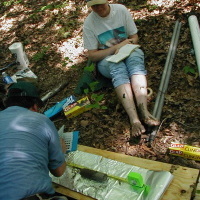



Uploads
Papers by Justin A Welbergen